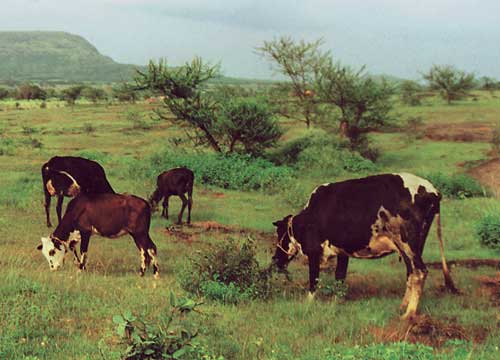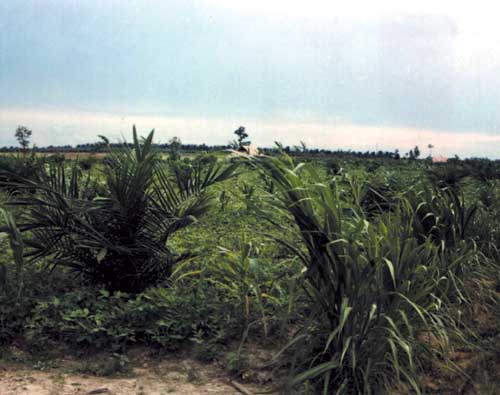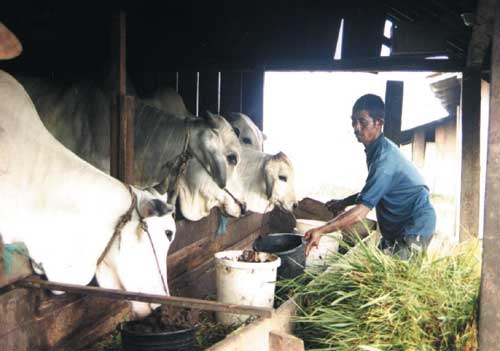Most of the discussions thus far have focused on technologies that range from feeding of crop residues, to recycling of dung and use of vaccines or dips to cure or prevent disease in animals. It has also been shown that a clear distinction between management and technological innovations could not be made (see Chapter 3). However, this chapter elaborates some issues that emphasize management and organization at animal, farm and regional level, such as:
A proper mix of indigenous and exogenous knowledge is likely to be effective in development of mixed systems - just as it is necessary to ally properly the interests of men, women, production and sales, etc. It will be seen that all these issues reflect the concept of the communal ideotype at farm, regional or even national levels and among disciplines.
The essence of the communal ideotype is that parts of a farm need to be mutually adjusted to ensure maximum output of the total. This adjustment should take place not only between parts in space (i.e. the goat has to be tethered to avoid crops being damaged), but also in time (i.e. the yield objective of the present crop may not be at the expense of future yields; that would be a case of soil mining). For example:
All these issues are typical in mixed systems but, as previously mentioned, they also occur elsewhere in society, thus making the work in mixed crop-livestock systems an ideal model for other sectors of society.
At village or regional level there are also examples of development based on involvement and mutual adjustment of all partners.
Landcare and Integrated Catchment Management (ICM) are two community participative organizations with a diverse membership in rural areas that includes primary producers, nature conservationists, government and industry. Land care in this sense is not a typical case of mixed crop-livestock farming, but it does represent a practical example of how issues in mixed farming systems translate into issues in development of society in general. Both Landcare and ICM involve all members of the community in the decision-making process for the management of catchments. Both these organizations mould together private use of land for agriculture with a philosophy that all land is held in trust for the use of future generations of human and other life. They do this by planning for long-term, sustainable use of land at a catchment level and use public and private funds to implement the plans at a property level, the epitome of the communal ideotype in space and time. Members of the organizations work together, and work with government bodies, to share information about best practices and to make incremental steps towards sustainable land use. Nature conservation groups are part of both organizations and they contribute to the thinking about what is current best practice for the needs of wildlife. They also help to implement the plans using both public funds and private donations of cash or kind. Landcare and ICM have developed into strong organizations that combine the interests of different system levels in space and time.
Sukhomajri lies in the hills, not far from Chandigarh in northwest India. The hills, once heavily wooded, have suffered from increasing human and livestock populations, leading to overgrazing and severe erosion. Barely 5 percent of the uplands had vegetation cover in the 1970s, and erosion rates of 150-200 tonnes/ha were not uncommon. In 1958 a dam was constructed, creating a lake to serve the city of Chandigarh, but by 1974 over 60 percent of the lake was filled with sediment. To protect the lake, the authorities first tried to persuade the gujjar herdsmen of the village to stop using the hills for their cattle and goats, but with little result. The breakthrough came when it was decided to build a small earthen dam in the hills to provide water for the village itself and then to stabilize the catchment of this dam. The stored water was used to irrigate nearby fields and farmers were provided with subsidized seed and fertilizer. Yields were greatly increased but farmers who did not benefit continued to use the hills for grazing. It was then that the villagers collectively proposed that more small dams should be created to extend the irrigation system. They also suggested the creation of a water users' society, based on the principle of equity, to manage the water. A "coupon" system was introduced and families with little or no land could thus sell their water rights or use the water to sharecrop on land belonging to others who were short of water. Any member whose livestock was found grazing in the hills lost his or her rights to the water. The society was given responsibility for maintaining the dams and their catchments, for distributing the water, and for maintaining records.
From then on the village began to develop rapidly. The villagers sold off their goats and replaced them with high-yielding buffaloes to provide milk for the growing towns nearby. The buffaloes were stall-fed, using the rapidly growing fodder grasses in the hills. These first steps immediately brought benefits and helped enlist villagers for further experiments in improvement. For instance, the farmers began to experiment with green manures, which had not been tried before, and they developed new technologies based on velvet bean and lablab bean. As maize yields increased and subsistence was assured, the farmers began to turn to vegetable growing. The project is on a self-help basis, with no subsidies provided. By 1990 the farmers, with their own labour, had constructed some 300 km of erosion works. Out-migration has largely ceased and the landless in the area are benefiting from an increase in the daily wage. Many landless have begun to establish rights to land that previously they had considered useless but which under the new technologies is proving productive.
Natural resources are in short supply in the Koutiala area, one of the oldest cotton production areas of Mali. Villagers complain about townspeople cutting firewood and grazing herds in the bush. In an attempt to regulate the use of the natural resource base a pilot project with six villages has been set up. They have been collaborating with other users of the natural resources and with research, extension and local authorities to manage their territory. Over the years plans have been put to work to control grazing, cutting of firewood, livestock feed and other uses of the resources. The plans included intensification of agriculture, integration of agriculture and livestock, fodder crop production, erosion control, establishment of tree nurseries, reforestation, and adaptation of improved cooking stoves. Respect of traditional laws, for example on when and how to exploit certain tree species, has been included in the protocol. The whole approach has been based on participatory methods. Chosen villagers represented the villages and they gave feedback to the village on results reached or measures proposed to control their environment. It took a long time to get the different stakeholders together. The process was slow, with conflicting interests, but in the end an agreement was reached, the protocol was tested and is now being implemented. The cutting of firewood is regulated. There are rules for grazing, rotational grazing and bush fires, and cutting heights of trees are fixed to enable regrowth.

Unrestricted grazing can cause damage to existing vegetation and seedlings of trees and grasses, leading to overgrazing, mining and deterioration of the resources (India)
Farmers in the Hindu Kush-Himalayas had mixed reactions regarding community forestry. Some felt that it had a positive impact on fodder supply because of natural growth as a result of protection, but others thought that controlled harvesting of natural grass and leaves would decrease the availability of fodder resources. A minimum fee could be paid on a monthly basis to acquire fodder grass from community owned lands, but poor farmers did not find this acceptable. With the increasing scarcity of fodder, farmers searched for alternatives. A greater number of farmers addressed fodder scarcity through use of their own lands. In some villages, about 30-40 percent of the land-rich farmers have private land, Kharbaris (marginal sloping land), on which grass and fodder trees are grown more intensively. Increased fodder shortages and the high cost of feed provided incentives for the increased cultivation of trees on farms. There has also been an increase of growing leguminous fodder trees on the bunds of cultivated terraces. During the winter months, maize stalks and badhar (Artocarpus lakoocha) are fed to livestock. Farmers also save dry fodder (rice and wheat straw, maize, stover, etc.) during this period to feed large ruminants but, as the amount available is not sufficient to feed them all winter, in some villages farmers have adapted to winter fodder shortages by cultivating exotic oats, sometimes cultivated after the rice harvest, to replace wheat. Also, some resource-poor farmers have responded to the lack of fodder from their private land by making arrangements to harness fodder from the private land of resource-rich farmers.
Not only farmers and their communities have to change their attitudes, also the people and institutions at government level may have to collaborate in adjusting their priorities to make livestock development and mixed farming a success. Typical cases range from the privatization of veterinary care to the reorientation of research and extension programmes.
Traditionally the tasks of veterinary services in developing countries include active veterinary care: vaccinations, health care and marketing of veterinary and feed products. However, state-organized veterinary services have been increasingly incapable of responding to the growing demand for veterinary care because of budget restrictions, inefficient services and inefficient handling of revolving funds. Therefore, the privatization of veterinarian services was stimulated to continue offering animal health care after the Structural Adjustment Programs of the World Bank and IMF. Multilateral donors, such as the European Union, support private veterinarians through credit schemes and trade guarantees and the functioning of veterinary care on an open market is expected to increase availability and to improve the quality of animal health care. Better adjustment of the services offered and services needed is expected from privatization, though this may work better for one situation than for another. The prevention of diseases of national importance may be less effectively tackled if farmers determine demand for services only.
Privatization has indeed been successful to some extent. However, the private veterinarian hardly covers remote areas because costs of transport are prohibitive and demand for services is low. In many African countries the adjustment process is progressing slowly, but the privatization of vaccination campaigns against bovine pest and contagious bovine pleuropneumonia has been quite successful in Chad (Domenech, 1994). The trade of veterinary products has been successfully liberalized in Mali, but at first the availability of private agents restricted the range of vaccination programmes and prevention against trypanosomiasis. The success of privatization also depends on the organizational capacity of the veterinarians and their willingness to work in an insecure financial situation. Donors have stimulated governments to change the legal framework to facilitate the work of these veterinarians. However, the application of this framework depends on the veterinary services. Veterinarians have professional associations that can put pressure on government to either activate or discourage the new legal frameworks and adjustment processes.
Privatization of the veterinary services in the Compagnie malienne pour le développement des textiles (CMDT) in the region of southern Mali has given mixed results. In some parts of south Mali, such as Kadiolo, the introduction of cotton and the related animal traction on the farm has been relatively recent. Veterinary services such as vaccination and deworming of oxen were carried out twice a year on the initiative of the cotton company (CMDT). Farmers were not fully informed about the usefulness of these programmes. Sometimes costs were deducted from the cotton yield without involving farmers, who were not likely to call upon the veterinarians themselves because they were unaware of the advantages of preventive treatment. At the same time, private veterinarians were not stationed in these regions, as the demand for their services was low. In these cases privatization had negative consequences because some farmers lost their only oxen that were acquired on credit. Also, in 1995 and 1996 when privatization was under way and when state agents and the CMDT were prohibited to intervene, an outburst of pasteurellosis occurred, while trypanosomiasis caused mortality in cattle. The cotton production of these farmers decreased because of the poor health of their oxen, and so did their capacity to reimburse the credit they had received for cotton farming and the animal traction equipment. In regions such as Koutiala, where introduction of animal traction started much earlier, farmers learned about the advantages of vaccination by experience as they invested their savings from cotton production in cattle. They were used to calling upon veterinary services for their animals. By experience they learned that only vaccination could prevent cattle from getting bovine pest, pasteurellosis, anthrax (endemic in the region) and contagious bovine pleuropneumonia. After privatization those farmers did not hesitate to bring their oxen for vaccination to private veterinarians that were already stationed and equipped with drugstores.

King grass planted on farmers' oil palm plantation areas in Kalimantan. King grass serves as fodder for the farm animals

Palm kernels can provide a useful feed. Here a farmer has fed the solid palm kernel waste to his animals, which they obviously enjoy
A major by-product from cotton is the cottonseed, which is pressed to extract oil. The resulting cake is a valuable feed for animals. The demand on the world market is high and industries are keen to sell large quantities to make a profit. Exports help to bring in foreign currency but reduce the availability of the by-products for the farmers that have produced the cotton. This is a form of disintegration, i.e. export leads to specialized livestock production in HEIA systems elsewhere while exchange of resources on the farm (the ideal of NCA) is reduced. In 1994, however, the newly created Union of Cotton Producers in Mali demanded the by-products of "their own" cotton. However, government and industry argued that the pastoralists in the north of the country also needed these supplements. Their interest was to reserve a part of the industrial by-product for the people in the north because these mobile nomads and transhumant livestock holders move south in the case of feed shortage. Their migration to pasture grounds and forest areas that were traditionally reserved for others had caused ethnic tensions on various occasions.
Much of the modern teaching and research tends to be focused on single commodities and disciplines. This monofocused approach on either breed, or feed, or health, or milk, or eggs, etc. has particularly hampered the development of mixed systems where animals perform several functions and where different aspects of animal production are to be mutually adjusted. Fortunately change is imminent and more research is now undertaken on issues of mixed farming worldwide (FAO, 1992c; Oomen et al., 1998; Powell et al., 1993; Devendra and Sevilla, 1995). This has led to new insights and approaches to teaching. For example cereal varieties are now tested for grain and straw characteristics as well as for ratooning capacity (Photos 98, 99, 100 and 101).

PHOTO 100
Testing of different rice varieties for characteristics such as grain yield, quality and quantity of straw (Sri Lanka)

PHOTO 101
Ratoon of a rice crop, i.e. young regrowth after harvest (Pakistan)
Mixed systems that are based on exchange of resources need to consist of parts that are finely tuned to each other - the principle of the communal ideotype. The principle is valid at all levels in the system hierarchy, i.e. a herd is composed of animals that function as a whole, and a mixed farm adjusts to humans, livestock and the soil. A region should consist of mutually adjusted production systems. At a still different level, it is also necessary to adjust government systems and farmer preferences, as well as to adjust research and teaching methods so as to provide maximum benefit.
2 Based on Roberts and Coutts (1997) and Campbell (1996).
3 Based on Conway and Barbier (1990).
4 Based on Hilhorst and Coulibaly (1998) and Joldersma et al. (1994).
5 Based on Tulachan and Neupane (1999).